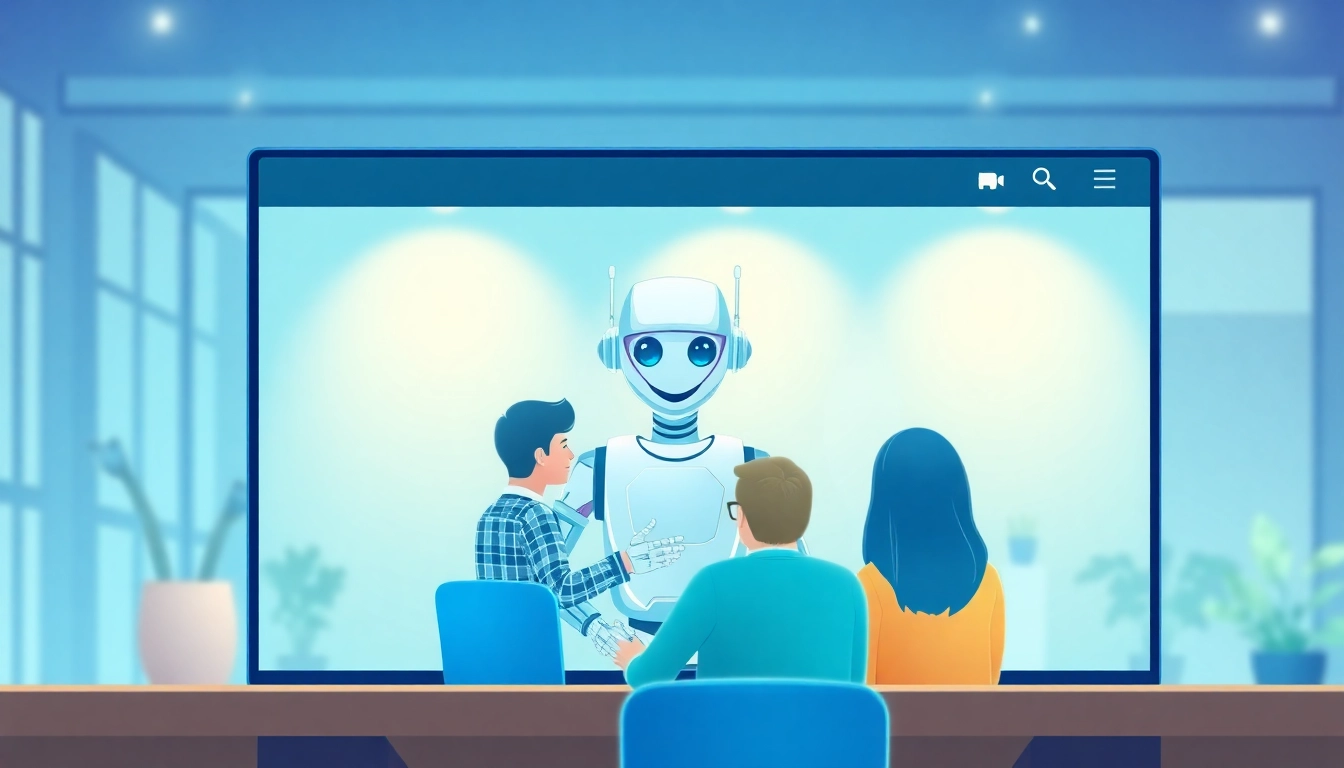
Understanding AI Chatbots and Their Benefits
What is an AI Chatbot?
An AI chatbot is a software application designed to simulate human-like conversations with users through voice or text interactions. Built on natural language processing (NLP) and machine learning technologies, these chatbots can understand user queries, provide instant responses, and continuously improve their performance by learning from past interactions. As the digital landscape evolves, integrating an AI chatbot for website is becoming essential for businesses aiming to enhance user engagement and streamline customer service.
Key Advantages of Implementing an AI Chatbot for Website
The integration of AI chatbots into websites brings a multitude of benefits. First and foremost, they provide 24/7 availability, ensuring that customer inquiries are handled at any hour without the need for human intervention. This leads to improved customer satisfaction as users can obtain information or assistance whenever required.
Furthermore, AI chatbots can handle multiple queries simultaneously, thereby increasing efficiency while decreasing response times. This is particularly beneficial during peak business hours, where human agents may be overwhelmed by inquiries. By automating routine tasks, organizations can free up their staff to focus on more complex issues, enhancing overall productivity.
Additionally, AI chatbots can reduce operational costs. By automating customer service functions, companies can save on human resources, training, and operational expenses associated with traditional customer service methods. Over time, this translates into significant savings that can be redirected to other strategic business initiatives.
Common Use Cases for AI Chatbots in Business
AI chatbots are being utilized across various industries, each tailored to meet specific needs. One common use case is in e-commerce, where chatbots assist customers with product inquiries, order tracking, and even personalized recommendations based on user behavior. In the healthcare sector, chatbots can manage appointment scheduling, provide information on medications, and engage in symptom checking, helping to streamline patient care.
Other notable applications include lead generation in marketing by collecting user information and qualifying leads through engagement, as well as providing real-time financial advice in banking and finance. The potential use cases are vast and can be customized to align with any business model or industry requirements.
Choosing the Right AI Chatbot for Your Website
Evaluating Features and Functionalities
Selecting the ideal AI chatbot involves assessing specific features and functionalities that align with your website’s objectives. Key features to consider include the chatbot’s ability to understand natural language, its integration capabilities with existing systems (such as CRM and e-commerce platforms), and the range of communication mediums it supports (e.g., text, voice, social media).
Additionally, look for chatbots with advanced analytics capabilities that provide insights into user interactions, satisfaction rates, and conversation effectiveness. These analytics can guide future improvements in your chatbot’s design and functionality.
Budget Considerations for Implementation
Your budget will influence the AI chatbot you choose, with pricing structures varying significantly based on the complexity of features and the size of your business. Many service providers offer tiered pricing models depending on the number of interactions, features, and support levels. It’s important to weigh these costs against the projected return on investment (ROI) from increased productivity and customer satisfaction.
Remember to factor in additional costs related to ongoing maintenance, updates, and possible integrations with other software systems. A well-planned budget will set realistic expectations and ultimately lead to a successful implementation.
Comparing Popular AI Chatbot Solutions
Numerous AI chatbot solutions exist in the market, making comparison crucial for finding the right fit. Prominent options include Tidio, Drift, and Intercom, each offering unique features tailored to different business needs. For example, Tidio is more user-friendly and suited for smaller businesses with straightforward needs, while Drift provides advanced lead generation features ideal for sales teams.
Evaluate each solution’s review ratings, customer support services, and ease of implementation. Free trials are often available, allowing businesses to test the functionality before making a financial commitment. Remember that the best solution will align closely with your business goals, technical requirements, and budgetary constraints.
Designing an Effective Chatbot User Interface
Best Practices for User-Centric Design
The design of your chatbot’s user interface (UI) is critical for maximizing user satisfaction. A well-designed UI should be intuitive and easy to navigate. Start by clearly defining your chatbot’s purpose and functionality, ensuring that users can easily understand how to interact with it.
Use simple language and avoid jargon to ensure that users of all backgrounds can engage with your chatbot. Incorporating visual elements like buttons and menus can lead to a smoother interaction, encouraging users to utilize the service without frustration. Additionally, comprehensive but concise onboarding prompts will help users get the most out of the chatbot experience from the outset.
Integrating Brand Voice and Personality
A successful chatbot does not merely function as an automated response tool; it embodies your brand’s voice and personality. This integration helps establish a connection with users, creating a more personalized and memorable experience.
To achieve this, consider what tone best reflects your brand. Is it professional, friendly, quirky, or authoritative? Once determined, ensure that the chatbot’s responses consistently align with this tone. Customizable templates or personality traits can help maintain uniformity in interactions, reinforcing brand identity.
Testing and Refining the Chatbot Experience
The launch of a chatbot should be seen as a starting point rather than the final product. Continuous testing and refinement are necessary to ensure optimal performance and user satisfaction. Implement A/B testing to compare different versions of the chatbot interface or dialogues, analyzing user responses and behaviors.
Gathering feedback from users immediately after interactions can provide insights into what works and what requires adjustment. Use this feedback to fine-tune responses, functionalities, and overall user experience continually.
Measuring Success and Performance Metrics
Key Performance Indicators for AI Chatbots
Understanding the success of your AI chatbot depends on tracking key performance indicators (KPIs). Common metrics include user engagement rates, resolution rates, average response time, and customer satisfaction scores. By tracking these KPIs, businesses can measure how well the chatbot meets user needs and how effectively it integrates with service goals.
Monitoring the conversation flow is also vital. Look out for drop-off points or common user frustrations that might indicate issues in the interaction design. By leveraging these insights, adjustments can be made to enhance responsiveness and deliver a more effective service to users.
Tools and Strategies for Monitoring Performance
Various analytical tools can aid in monitoring chatbot performance. Platforms like Google Analytics, HubSpot, and chatbot-specific analytics solutions can provide invaluable data regarding user interactions and overall effectiveness. These tools allow businesses to visualize interactions, track performance trends, and assess user engagement.
Regularly reviewing the performance data and synthesizing findings into actionable strategies will enhance the chatbot’s functionality over time. Engage with stakeholders to discuss insights and incorporate their suggestions, ensuring continued alignment with business objectives.
Adjusting Strategies Based on User Feedback
User feedback is a powerful resource when determining how to advance your chatbot. By encouraging users to share their experiences and suggestions through quick surveys or feedback forms, a wealth of information about the chatbot’s effectiveness can be gathered.
Implementing changes based on this feedback highlights your commitment to user satisfaction and can significantly increase engagement rates. Regular recalibration of the chatbot experience based on user-input data will create a more responsive and adaptive tool that aligns closely with evolving customer expectations.
Future Trends in AI Chatbots for Websites
Emerging Technologies Impacting Chatbots
The AI chatbot landscape is constantly evolving, driven by advancements in technology such as natural language processing, artificial intelligence, machine learning, and more recently, conversational AI. Emerging technologies allow chatbots to understand nuances in human conversation better and engage users in more meaningful interactions.
Voice-activated chatbots are also on the rise, reflecting the growing popularity of voice search and smart speakers. As these technologies become more prevalent, businesses will need to adapt their chatbot strategies to cater to this shift, ensuring that voice-based interactions are seamless and effective.
Anticipated Changes in User Expectations
As AI technology continues to advance, user expectations around chatbot capabilities are escalating. Today’s users expect an intuitive interface, rapid response times, and personalized interactions. They favor chatbots that can remember previous interactions and tailor responses based on past data.
Additionally, with growing concerns around privacy and data security, users are becoming increasingly discerning about how their data is handled. Businesses will need to remain vigilant in ensuring data security and transparency in chatbot interactions to maintain trust.
Strategies for Staying Ahead of AI Chatbot Trends
Keeping pace with industry trends requires a proactive approach. Staying informed through industry reports, webinars, and engaging with AI communities can provide insights into the latest developments and user expectations.
Regularly revisiting your chatbot strategy and experimenting with new features or technologies, such as integrations with augmented reality (AR) or virtual reality (VR), can set your service apart from the competition. Embracing innovation while prioritizing user needs will position your business as a leader in the rapidly evolving chatbot landscape.






